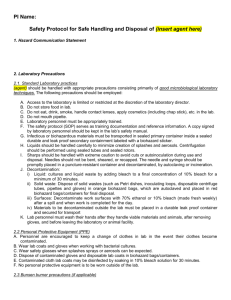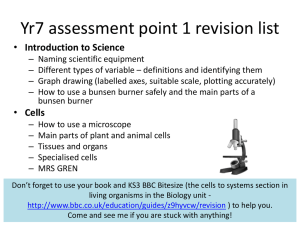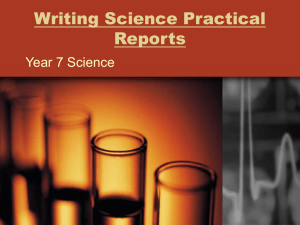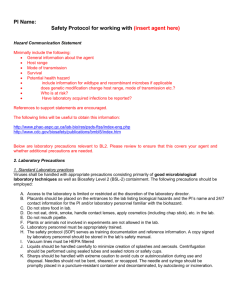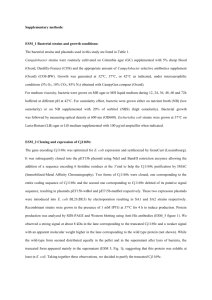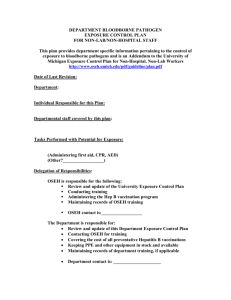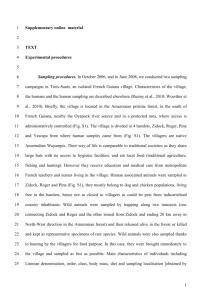E.coli (lab strains)
advertisement
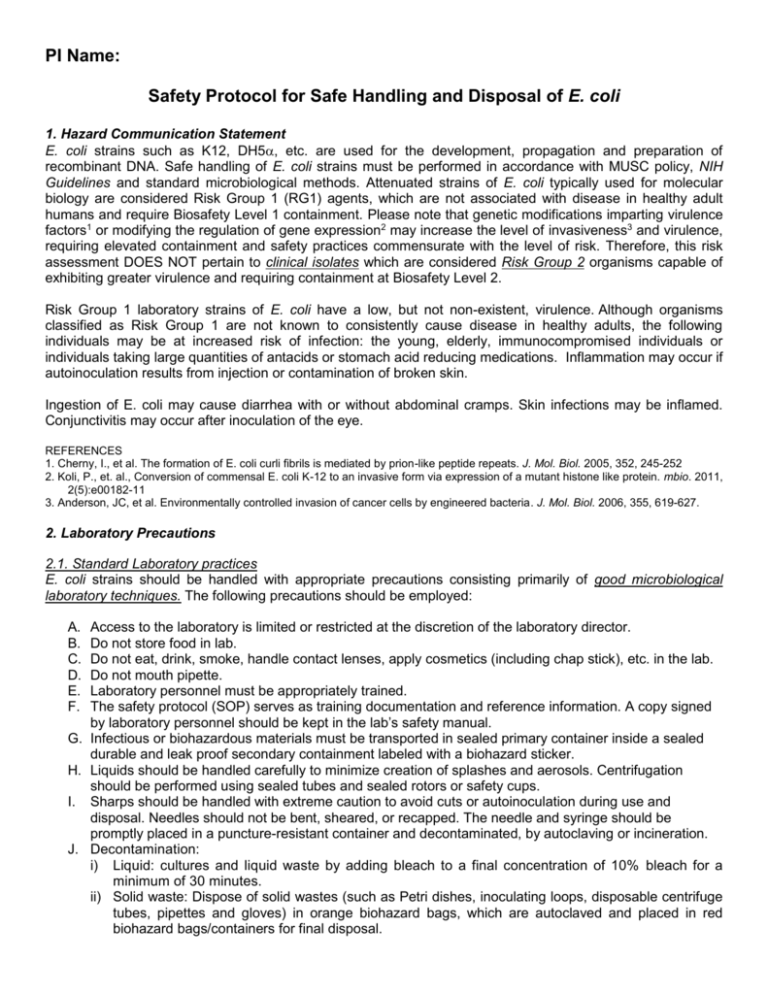
PI Name: Safety Protocol for Safe Handling and Disposal of E. coli 1. Hazard Communication Statement E. coli strains such as K12, DH5, etc. are used for the development, propagation and preparation of recombinant DNA. Safe handling of E. coli strains must be performed in accordance with MUSC policy, NIH Guidelines and standard microbiological methods. Attenuated strains of E. coli typically used for molecular biology are considered Risk Group 1 (RG1) agents, which are not associated with disease in healthy adult humans and require Biosafety Level 1 containment. Please note that genetic modifications imparting virulence factors1 or modifying the regulation of gene expression2 may increase the level of invasiveness3 and virulence, requiring elevated containment and safety practices commensurate with the level of risk. Therefore, this risk assessment DOES NOT pertain to clinical isolates which are considered Risk Group 2 organisms capable of exhibiting greater virulence and requiring containment at Biosafety Level 2. Risk Group 1 laboratory strains of E. coli have a low, but not non-existent, virulence. Although organisms classified as Risk Group 1 are not known to consistently cause disease in healthy adults, the following individuals may be at increased risk of infection: the young, elderly, immunocompromised individuals or individuals taking large quantities of antacids or stomach acid reducing medications. Inflammation may occur if autoinoculation results from injection or contamination of broken skin. Ingestion of E. coli may cause diarrhea with or without abdominal cramps. Skin infections may be inflamed. Conjunctivitis may occur after inoculation of the eye. REFERENCES 1. Cherny, I., et al. The formation of E. coli curli fibrils is mediated by prion-like peptide repeats. J. Mol. Biol. 2005, 352, 245-252 2. Koli, P., et. al., Conversion of commensal E. coli K-12 to an invasive form via expression of a mutant histone like protein. mbio. 2011, 2(5):e00182-11 3. Anderson, JC, et al. Environmentally controlled invasion of cancer cells by engineered bacteria. J. Mol. Biol. 2006, 355, 619-627. 2. Laboratory Precautions 2.1. Standard Laboratory practices E. coli strains should be handled with appropriate precautions consisting primarily of good microbiological laboratory techniques. The following precautions should be employed: A. B. C. D. E. F. Access to the laboratory is limited or restricted at the discretion of the laboratory director. Do not store food in lab. Do not eat, drink, smoke, handle contact lenses, apply cosmetics (including chap stick), etc. in the lab. Do not mouth pipette. Laboratory personnel must be appropriately trained. The safety protocol (SOP) serves as training documentation and reference information. A copy signed by laboratory personnel should be kept in the lab’s safety manual. G. Infectious or biohazardous materials must be transported in sealed primary container inside a sealed durable and leak proof secondary containment labeled with a biohazard sticker. H. Liquids should be handled carefully to minimize creation of splashes and aerosols. Centrifugation should be performed using sealed tubes and sealed rotors or safety cups. I. Sharps should be handled with extreme caution to avoid cuts or autoinoculation during use and disposal. Needles should not be bent, sheared, or recapped. The needle and syringe should be promptly placed in a puncture-resistant container and decontaminated, by autoclaving or incineration. J. Decontamination: i) Liquid: cultures and liquid waste by adding bleach to a final concentration of 10% bleach for a minimum of 30 minutes. ii) Solid waste: Dispose of solid wastes (such as Petri dishes, inoculating loops, disposable centrifuge tubes, pipettes and gloves) in orange biohazard bags, which are autoclaved and placed in red biohazard bags/containers for final disposal. iii) Surfaces: Decontaminate work surfaces with 70% ethanol or 10% bleach (made fresh weekly) after a spill and when work is completed for the day. iv) Materials to be decontaminated outside the lab must be placed in a durable leak proof container and secured for transport K. Lab personnel must wash their hands after they handle viable materials and animals, after removing gloves, and before leaving the laboratory or animal facility. 2.2 Personal Protective Equipment (PPE) A. Personnel are encouraged to keep a change of clothes in lab in the event their clothes become contaminated. B. Wear lab coats and gloves when working with bacterial cultures. C. Wear safety glasses when splashes sprays or aerosols can be expected. D. Dispose of contaminated gloves and disposable lab coats in biohazard bags/containers. E. Contaminated cloth lab coats may be disinfected by soaking in 10% bleach solution for 30 minutes. F. No personal protective equipment is to be worn outside of the lab. 2.3 Bunsen burner precautions Bunsen burners pose an obvious fire hazard. Proper adjustment and use are important. Please observe the following precautions when using a Bunsen burner. A. Locate the fire extinguisher prior to igniting the Bunsen burner. B. Clear your lab bench of any clutter and debris that might accidentally catch fire. Keep containers of alcohols and other flammables at a safe distance. C. Keep the burner on only when in use and be mindful of the flame, which can burn quietly and may appear almost invisible under fluorescent lights. Individuals may forget the burner is ignited and inadvertently pass an arm or lean over it. D. Adjust the burner’s gas flow and air intake to ensure optimum performance. E. Individuals with long hair may be at increased risk of accidentally singeing or burning their hair and shall reduce this risk by tying back or in some way biding their hair. F. Note: The fire hazard associated with Bunsen burners can be mitigated by utilizing electric microincinerators rather than traditional Bunsen burners. 3. Emergency procedures 3A. Spills of bacterial cultures: 1) Notify workers in the area. 2) Leave the area for 15 minutes to allow aerosols to settle. Replace contaminated PPE. 3) Upon return, mix spill with freshly made bleach to 10% final concentration. 4) Allow 30 minutes of contact time for disinfection. 5) Absorb spill with paper towels and dispose them into biohazard bags. 6) Use dustpan and broom to sweep up debris. Broken glass must be deposited into broken glass or sharps box. 7) Wipe the spill area clean using 10% bleach. 8) Dispose of contaminated PPE in autoclavable biohazard bags. 3B. In the event of injury or exposure 1) CLEANSE WOUND: Wash all wounds immediately with antiseptic soap and a high volume of water for up to 15 minutes. 2) CONTROL BLEEDING: Apply bandage and firmly press to control bleeding. 3) ACCIDENTAL INGESTION: Rinse mouth with water but do not swallow. 4) SEEK IMMEDIATE MEDICAL FOLLOW-UP (do not wait 24 hrs) Employees and students go to: Employee Health Services (during business hours: Monday-Friday, 7:30 am -4 pm). Address/Location: 57 Bee Street, Charleston SC 29425; Phone: (843) 792-2991 MUSC Emergency Room (after business hours) Address/Location: 96 Jonathan Lucas Street, Charleston SC 29425 Be prepared to discuss the nature and risks of this agent with the physician. 5) REPORT EXPOSURE IMMEDIATELY to the Principal Investigator and notify Biosafety Officer (843792-3604). 6) NOTIFY Employee Health Services within 24 hours by filing an ACORD First Report of Injury form at https://www.carc.musc.edu/acord/ By signing below I attest that I have read and understood these safety instructions and agree to adhere to these rules at all times. Furthermore, I feel I have been properly notified and trained of the hazards in this laboratory. Name (print) Signature ___________________________________ _________________________________ Date: ___________ ___________________________________ _________________________________ Date: ___________ ___________________________________ _________________________________ Date: ___________ ___________________________________ _________________________________ Date: ___________ ___________________________________ _________________________________ Date: ___________ ___________________________________ _________________________________ Date: ___________ ___________________________________ _________________________________ Date: ___________ ___________________________________ _________________________________ Date: ___________ ___________________________________ _________________________________ Date: ___________
